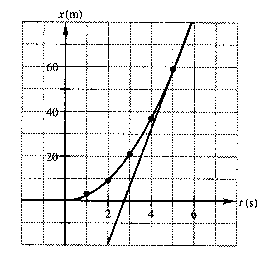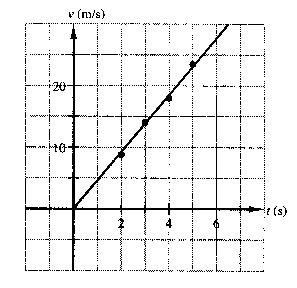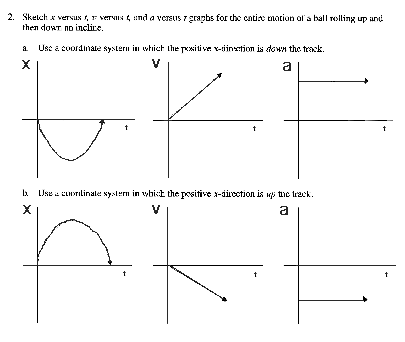
Homework #1
Ch. 1: 36,37; Ch. 2: 8,11,21,37,46; Homework Book: page 13: 2
1.36.a)

1.36. b)
![]()
![]()
![]()
![]()
![]()
![]()
1.37. a)
![]()
![]()
1.37. b)
![]()
![]()
2.8. a)

2.8. b)
At t = 5.0 s, the slope is ![]()
At t = 4.0 s, the slope is ![]()
At t = 3.0 s, the slope is ![]()
At t = 2.0 s, the slope is ![]()
2.8. c)

![]()
2.8. d)
The initial velocity of the car was zero.
2.11.
Choose the positive direction to be the outward perpendicular to the wall.
![]()
![]()
2.21. a)
![]() ,
, ![]()
![]()
![]()
x = 1000m, and t = 20.0s
2.21. b)
No, at this acceleration the plane would overshoot the runway. (Oops.)
2.37.
The total time to reach the ground is given by
![]()
![]()
![]()
Therefore, the time it takes to fall the first fifteen meters is found similarly:
![]()
![]()
So, ![]() suffices for the last ten
meters.
suffices for the last ten
meters.
2.46.
The distance travelled by the car ![]()
Distance travelled by the train ![]()
Therefore, the train leads the car by 1.38km.
Problem #2, Homework Book page 13.
a,b)

c) The differences in graphs arise solely from the choice of coordinate axes. There physical phenomenea are the same in both.
d) Absolutely. Consider the case of an object falling in a uniform gravitational field. If the positive direction is taken to be up, then the acceleration that is felt is negative, while the magnitude of the velocity (speed) is increasing.